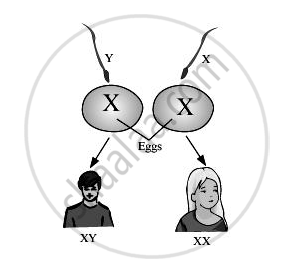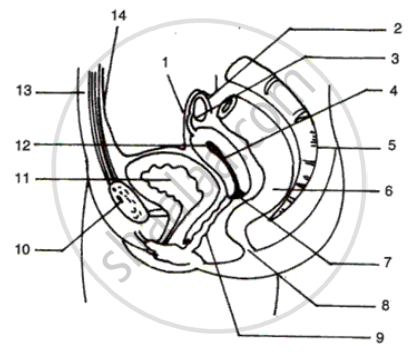Advertisements
Advertisements
प्रश्न
Gender of child is determined by the male partner of couple. Explain with reasons whether this statement is true or false.
उत्तर
Human females have two X chromosomes (XX) and human males have one X and one Y chromosome (XY). Therefore, the eggs produced by females have only X chromosomes while the sperms produced by males can have either X or Y chromosome. If an unfertilised egg fuses with a sperm containing X chromosome, then it gives rise to a girl child having two X chromosomes. If an unfertilised egg fuses with a sperm containing Y chromosome, then it gives rise to a male child having one X and one Y chromosome.

APPEARS IN
संबंधित प्रश्न
Name any three parts of the female reproductive system in human beings. Write one function of each.
What is placenta?
Describe placenta structure.
Write the functions of the following parts in human female reproductive system:-
(i) Ovary
(ii) Oviduct
(iii) Uterus
What is the main difference between sperms and eggs of humans? Write the importance of this difference.
What are the changes seen in girls at the time of puberty?
Which of the following is not a part of the female reproductive system in human beings?
State the changes that take place in the uterus when Female gamete/egg is not fertilised
Mention the total number of chromosomes along with the sex chromosomes that are present in a human female and a human male. Explain how in sexually producing organisms the number of chromosomes in the progeny remains the same as that of the parents.
When a cell reproduces, what happens to its DNA?
Write the function of the following part in a human female reproductive system:
Fallopian tube
List the two types of reproduction. Which one of the two is responsible for bringing in more variations in its progeny and how?
Give appropriate biological/technical terms for the following:
The kind of twins formed from two fertilized eggs.
Give scientific reasons: Mature erythrocytes in humans lack nucleus and mitochondria
The structure formed by the villi of the embryo and the uterus of the mother.
State the main function of the Sperm duct.
Describe in brief the structure of placenta
Give biological explanations for The placenta is an important structure for the development of a foetus
Where is the male gamete formed in humans?
Mention two functions of human ovaries.
How long does a human baby take to develop before birth?
What changes are seen in boys at the time of puberty?
Fertilisation results immediately in the formation of :
(a) a zygote
(b) an embryo
(c) a placenta
(d) a foetus
During adolescence, several changes occur in the human body. Mark one change from the following associated with sexual maturation in boys.
In humans, the fertilization takes place in:
Describe in brief the role of ureter in human male reproductive system.
List and explain in brief three methods of contraception.
Diagram shows the reproductive system of female human beings:
(i) Name the parts numbered 1 to 14.
(ii) Normally, after how many days does an ovary release an egg?
(iii) Where are the sperms released during coitus?
(iv) What is the role of sperms after their ejaculation in vagina?
(v) What is the function of the organ numbered 5?
(vi) What is the gestation period in human?

Draw a diagram to display the vertical view of human female reproductive system and label the following parts in the diagram:
(1) Ureter
(2) Ovary
(3) Funnel of fallopian tube
(4) Urethra.
What are the signs of puberty in human males and females?
Differentiate on the basis of what is indicated in brackets :
The prostate gland and Cowper’s gland (the nature of secretion)
Give Reasons
At the time of birth, the testes descend into the scrotal sacs.
Name the Following
What does this abbreviation stand for LH?
Mention, if the following statement is True or False. If false rewrite the wrong statement in its correct form:
A zygote is the product of the fusion of male and female gametes.
Choose the Odd One Out:
Choose the Odd One Out:
The living organisms can be unexceptionally distinguished from the non-living things on the basis of their ability for ______.
